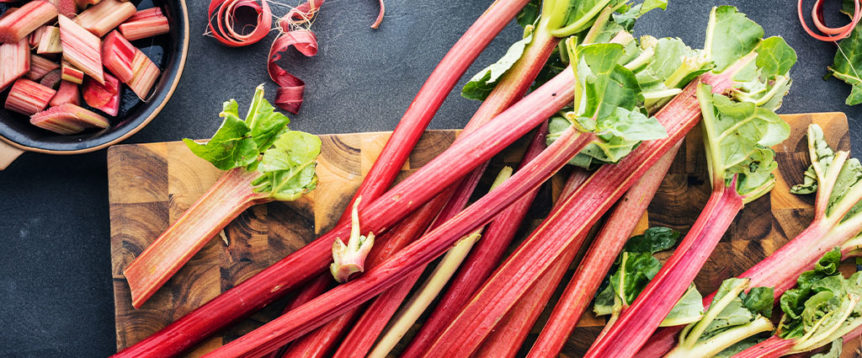The reappearance of ruby-red rhubarb is a signal that summer has begun. The plant is a favorite for pies. But are there other ways to cook with it? How can you make it edible without adding endless amounts of sugar? We explore these questions, plus one that never seems to go away: Are the leaves really toxic?
What Is It?
Rhubarb is often considered a fruit but is actually a vegetable. Its high acid content gives it a tart flavor that contrasts nicely with sweet ingredients. Rhubarb is naturally high in vitamin K, vitamin C, manganese, calcium and fiber.
The best-quality rhubarb stalks are pink to bright red, although the green ones can be quite good, too. Look for stalks that are small to medium-sized in girth; thick ones tend to be stringy. Harvest season can last from March to mid-June, depending on local growing conditions.
Beyond Pies: 4 Unique Ways to Use Rhubarb
Also called “pieplant,” rhubarb is best-known as an ingredient in pies and crisps. But what else can you do with it?
- Try making a rhubarb syrup to flavor soda water, punch, cocktails or other drinks. Boil the stalks with sugar and water until thick; then store in the refrigerator.
- Rhubarb is terrific in quick breads and muffins. Adding blueberries or a sprinkling of cinnamon-laced streusel will lend sweetness to low-sugar recipes that use this pungent ingredient.
- Tart rhubarb provides a nice contrast to rich meats. Embrace its sourness by using it (without sweetener) in stews, braises and baked dishes.
- Rhubarb can also be cooked as a compote that’s delicious on yogurt, cheesecake or chia seed pudding, or in jams and jellies that are perfect for topping toast, biscuits and pancakes.
Preparing and Preserving
Rhubarb can be wrapped in plastic and stored in the refrigerator for up to three weeks. Before cooking it, dispose of any leaves. They contain high levels of oxalic acid, which can be poisonous to people and pets. (They are, however, safe to put in compost bins.) Because rhubarb is high in acid, it should be cooked in a nonreactive pan (best options include ceramic, stainless steel, glass or nonstick materials; aluminum, unlined copper and cast iron are all considered “reactive” metals because they react chemically with foods and can alter flavor and color of the food cooked).
To extend the rhubarb season, cut stalks into half-inch pieces and freeze them on a baking sheet. Place the frozen slices in a bag, push out the air, and store for up to six months.
Are Rhubarb Leaves Toxic?
Rhubarb leaves are considered inedible due to a high concentration of oxalic acid which can cause build-up in the organs and lead to kidney stones and kidney failure when consumed in high amounts.

